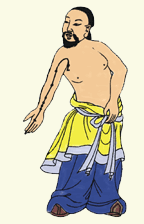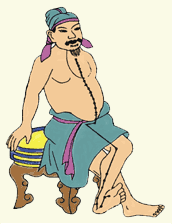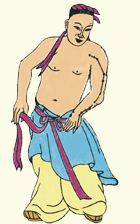Lifestyle
Articles
Yoga Manual
FAQ
NAET Diet
Diet
New Patients
About Ian
Yoga Classes
|
The Point of the Needle
by John Silverlight
A personal account of Five Element Acupuncture treatment
First published in the Observer Newspaper
London, England

Until two years ago I had never had much wrong with me, barring accidents. Then I had two unpleasant, protracted illnesses: colitis in 1981 and prostate trouble last year. The colitis never made me miss more than one or two days' work at a time, but it was energy-sapping; my weight went down by nearly a stone. No sooner was it back to normal than the prostate went wrong.
I did not want surgery, in spite of the fact that two friends had recently had operations and were leading much improved lives as a result. Not that I am an enemy to conventional medicine and surgery. On the contrary, antibiotics and devoted doctoring saved my son when he had pneumonia at the age of two. Sulphonamides saved my leg, and my life, when I was wounded in 1942.
But I was starting a new job and it would have been most inconvenient to take three or four weeks off. Yet things could not go on as they were. Besides the fact that my weight was again dropping sharply, life was becoming extremely uncomfortable.
Just then I happened to talk to a friend, the mother of a young woman who practices acupuncture. Why not try it, I wondered, and my friend gave me the name of an acupuncturist who, like her daughter, had trained at the College of Traditional Acupuncture, in Leamington Spa, England.

I made an appointment and began to read about acupuncture. Some of it was fascinating: how the legendary Yellow Emperor of China 5,000 years ago asked his chief physician, "In regard to the nine needles (for acupuncture)...let me be informed about their workings...I should like to be informed about Nature to the utmost degree, including Man, his body, his blood, his vital energy...what causes his death and his life and what we can do about all this." (The Yellow Emperor's Classic of Internal Medicine, University of California Press); how the Chinese were aware of the circulation of the blood 15 centuries before William Harvey published his essay on it in 1628 (Celestial Lancets, by Lu Gwei-djen and Joseph Needham, Cambridge University Press); how Hector Berlioz's father, a doctor, published a book on acupuncture in 1815.
Many of the ideas were, besides being incomprehensible, alien to me. Chinese cosmology includes the concepts of Yin and Yang and Chi (energy which flows through the body along twelve pathways or meridians). The acupuncture points lie along the meridians, and hairfine needles are inserted in them in order to redistribute the energy flow. According to ancient Chinese thought, these Five Elements, or Five Moving forces, together make up a dynamic system of correspondences, which covers everything in nature, including the human body, mind and spirit.
The first appointment consisted of talking about myself for two hours: childhood and relationships with my parents; medical background; daily pattern of life-how I ate, slept and so on; my reactions to the seasons; emotional disposition-did I have 'up' days and 'down' days? It was all most enjoyable. We made another appointment and the acupuncturist asked me not to use aftershave that day: odor is an important guide to diagnosis.
In traditional acupuncture the whole is seen through the Five Elements. The practitioner uses the subtle signs and symptoms to diagnose the underlying cause of an illness, which is a result of an imbalance of the chi. There are five odorous used in diagnosis: rotten, putrid, rancid, scorched and fragrant.
There are five emotions: fear, anger, joy,
sympathy and grief.
The colors that show in the face are important too, and again there are five: blue, green, red, yellow and white. Also important are five sounds in the voice: weeping, groaning, shouting, laughing and singing. There are also five basic emotions: fear, anger, joy, sympathy and grief. All this is part of the Law of the Five Elements, on which the teaching of the College of Traditional Acupuncture is based. And still it did not make sense to me. The acupuncturist told me not to worry. Understanding might or might not come. It did not matter.
Treatment proper started with the second session. I stripped to my underclothes and lay down on the table. The acupuncturist began by taking my pulse, an immensely more complicated business than in Western medicine.
There are 12 pulses, six on each wrist, which indicate the quantity and quality of Chi in each meridian, or organ, and in the whole body. Each pulse has 28 qualities: pulse-reading takes years to master.

My acupuncturist explained that treatment is decided on the basis of the pulse picture along with the odorous, colors, sound of the voice and predominating emotion, as well as information gathered from the patient. I was beginning to see a pattern, especially when he said that while he was naturally concerned with my symptoms-it was prostate that had brought me to him--as a traditional acupuncturist, he was more interested in what he called the 'core phenomenon': the whole, well person.
"Health and well-being," he went on, "depend on a series of inter-related regulatory mechanisms generated both within us and from our inter-reactions with the environment that sustains us. When the processes fall out of harmony, the person falls sick. This harmony is defined in the traditional Chinese way in terms of defects in the flow of energy between our organs."
Just to hear the names Bubbling Spring and Penetrating Valley was pleasurable.
He was going to decide where to insert needles into the body "in order to establish, with the minimum intervention possible, a more harmonious energy flow," and to enable my own health regulatory mechanism to become reinstated. He decided to work first meridians of the Water Element. He inserted two needles in each foot-the sensation was slight-and removed them after about 20 minutes. That day I felt desperately tired; work went badly.
The treatments went on. I was not aware of any real improvement. However, I had gone into the thing with not much hope and no expectations. It was early days. I knew I must be patient. I enjoyed the sessions, learning about acupuncture; just to hear the names of the points-Bubbling Spring, Greater Mountain Stream, Kun Lun Mountain, Penetrating Valley and so on-was pleasurable.
During one treatment we discussed my diurnal and seasonal rhythms (it was now late autumn). In acupuncture the year is divided into five seasons, as one might expect: spring, summer, late summer (harvest time), autumn and winter. Suddenly I was aware of two things: first, that the world about me was a vast system of rhythms, of which I felt part as I had never been conscious before; second that I felt better: not just better than before the prostate went wrong but better than I had felt for years.
I felt better than I had in years.
That awareness has stayed with me. It is reinforced by my having at last taken in that acupuncture is not so much about curing sickness as about maintaining health. "In ancient China," Dr. Felix Mann writes in his Acupuncture: the Ancient Chinese Art of Healing, "the doctor was paid by the patient when he was healthy and the payment was stopped when he was ill." In my case a 'guardedly optimistic prognosis' has been made and the treatments are being spaced out. I may be treated as seldom as two or three times a year. These treatments, usually given at the change of one of the seasons, help to keep the chi in balance, and maintain good health.
Other Articles:
|